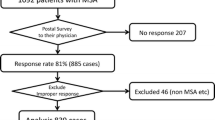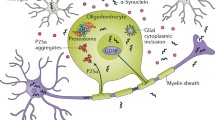Abstract
The various clinical features of multiple system atrophy (MSA) make the diagnosis of the disease difficult, especially in its early stages, when signs of differentiated neuroanatomical system involvement have not yet appeared. Mortality studies may be affected by the variability of the diagnostic criteria and selection bias. We used strict clinical and MRI criteria to diagnose MSA in 59 patients. Patients with parkinsonian and cerebellar onset were compared. Median survival time from the onset of the first motor symptom was 7.5 years. Our results indicated a trend (P = 0.09) for the Northwestern University Disability Scale score to correlate with mortality, but we failed to find other characteristics identifying subgroups or predictors for survival.
Similar content being viewed by others
References
Canter GJ, DeLaTorre R, Mier M (1961) A method for evaluating disability in patients with Parkinson's disease. J Nerv Ment Dis 122:143–147
Graham JG, Oppenheimer DR (1969) Orthostatic hypotension and nicotine sensitivity in a case of multiple system atrophy. J Neurol Neurosurg Psychiatry 32:28–34
Gray F, Vincent D, Hauw JJ (1988) Quantitative study of lateral horn cells in 15 cases of multiple system atrophy. Acta Neuropathol (Berl) 75:513–518
Harding AE (1981) “Idiopathic” late onset cerebellar ataxia. A clinical and genetic study of 36 cases. J Neurol Sci 51:259–271
Klockgether T, Schroth G, Diener H-C, Dichgans J (1990) Idiopathic cerebellar ataxia of late onset: natural history and MRI morphology. J Neurol Neurosurg Psychiatry 53:297–305
Lantos PL, Papp MI (1994) Cellular pathology of multiple system atrophy: a review. J Neurol Neurosurg Psychiatry 57:129–133
Larsen JP, Dupont E, Tandberg E (1994) Clinical diagnosis of Parkinson' disease. Proposal of diagnostic subgroups classified at different levels of confidence. Acta Neurol Scand 89:242–251
Oppenheimer D (1982) Neuropathology of progressive autonomic failure. In: Bannister R (ed) Autonomic failure. A textbook of clinical disorders of the autonomic nervous system. Oxford University Press, Oxford, pp 267–283
Parati EA, Fetoni V, Geminiam GC et al. (1993) Response to 1-DOPA in multiple system atrophy. Clin Neurophannacol 16:139–144
Pastakia B, Polinski R, DiChiro G et al. (1986) Multiple system atrophy (Shy-Drager syndrome): MR imaging. Radiology 159:499–502
Perani D, Bressi S, Testa D et al. (1995) Clinical/metabolic correlations in multiple system atrophy. A fluorodeoxyglucose F 18 Positron Emission Tomographic study. Arch Neurol 52:179–185
Quinn N (1989) Multiple system atrophy — the nature of the beast. J Neurol Neurosurg Psychiatry [Suppl] : 78–89
Quinn N (1994) Multiple system atrophy. In: Marsden CD, Fahn S (eds) Movement disorders 3. Butterworths, London, pp 262–281
Savoiardo M, Strada L, Girotti F et al. (1990) Olivopontocerebellar atrophy: MR diagnosis and relationship to multisystem atrophy. Radiology 174:693–696
Schulz JB, Klockgether T, Petersen D et al. (1994) Multiple system atrophy: natural history, MRI morphology and dopamine receptor imaging with123IBZM-SPELT. J Neurol Neurosurg Psychiatry 57:1047–1056
Testa D, Fetoni V, Soliveri P et al. (1993) Cognitive and motor performance in multiple system atrophy and Parkinson's disease compared. Neuropsychologia 31:207–210
Testa D, Savoiardo M, Fetoni V et al. (1993) Multiple system atrophy. Clinical and MR observations on 42 cases. Ital J Neurol Sci 14:211–216
Wakai M, Kume A, Takahashi A, Ando T, Hashizume Y (1994) A study of parkinsonism in multiple system atrophy: clinical and MRI correlation. Acta Neurol Scand 90:225–231
Wenning GK, Ben Shlomo Y, Magalhaes M, Daniel SE, Quinn NP (1994) Clinical features and natural history of multiple system atrophy. An analysis of 100 cases. Brain 117:835–845
Wenning GK, Ben-Shlomo Y, Magalhaes M, Daniel SE, Quinn NP (1995) Chnicopathological study of 35 cases of multiple system atrophy. J Neurol Neurosurg Psychiatry 58:160–166
Author information
Authors and Affiliations
Rights and permissions
About this article
Cite this article
Testa, D., Filippini, G., Farinotti, M. et al. Survival in multiple system atrophy: a study of prognostic factors in 59 cases. J Neurol 243, 401–404 (1996). https://doi.org/10.1007/BF00868999
Received:
Revised:
Accepted:
Issue Date:
DOI: https://doi.org/10.1007/BF00868999




